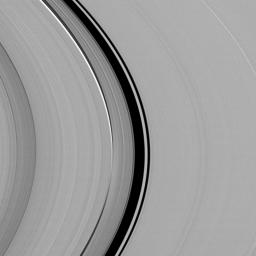The Synchronicity of Rhythms
Caption:
A dynamical interplay between Saturn's largest moon, Titan, and its rings is captured in this view from NASA's Cassini spacecraft.
At every location within Saturn's rings, particles orbit with a particular period, or rhythm. This image is focused on two separate and nearby locations in the rings where those rhythms are in synchrony with different aspects of Titan's 16-day orbit, creating signature effects that point from a distance back towards Titan.
The Titan Ringlet, embedded within the Colombo Gap at the center of this image, is slightly oval-shaped and always points its long axis towards Titan. The behavior and orientation of the ringlet are controlled by a gravitational resonance between Titan's 16-day orbit and the rate at which ring particles' oval-shaped paths rotate ("precess") around the planet. Because the particles' orbit precession is sensitively tied to Saturn's internal gravity structure, the radial location of the Titan Ringlet supplies scientists with the best available measurement of the outer layers of Saturn's interior.
Just inward of the gap is a very narrow feature that transitions from bright at the top of the image to dark at the bottom. This is a bending, or vertical, wave generated by a similar resonance with Titan, but this time it involves a synchronicity between the out-of-plane motion of Titan, which is on an inclined (tilted) orbit and similar motions of the ring particles with their own inclined orbits. In this image, taken near Saturn's 2009 equinox when sunlight hit the rings nearly edge-on, the vertical structure of the bending wave is obvious because of shadows giving it an unusual bright-to-dark appearance.
Also visible because of the shallow illumination angle is the vertical corrugation that crosses the entire C ring. This is the after-effect of a large impactor that is believed to have hit the inner Saturnian rings around the year 1983. Looking like a pattern of faint stripes, the corrugation is best seen on the right-hand side of the image, where other ring structure is sparse.
This view looks toward the sunlit side of the rings from about 9 degrees above the ring plane. The image was taken in visible light with the Cassini spacecraft narrow-angle camera on Sept. 20, 2009.
The view was obtained at a distance of approximately 288,000 miles (463,000 kilometers) from Saturn and at a sun-Saturn-spacecraft, or phase, angle of 13 degrees. Image scale is 1 mile (2 kilometers) per pixel.
Background Info:
The Cassini-Huygens mission is a cooperative project of NASA, the European Space Agency and the Italian Space Agency. The Jet Propulsion Laboratory, a division of the California Institute of Technology in Pasadena, manages the mission for NASA's Science Mission Directorate, Washington, D.C. The Cassini orbiter and its two onboard cameras were designed, developed and assembled at JPL. The imaging operations center is based at the Space Science Institute in Boulder, Colo.
For more information about the Cassini-Huygens mission visit
http://saturn.jpl.nasa.gov
and
http://www.nasa.gov/cassini
. The Cassini imaging team homepage is at
http://ciclops.org
.
Cataloging Keywords:
| Name |
Value |
Additional Values |
| Target |
Saturn Rings |
C Ring, Saturn, Titan |
| System |
Saturn |
|
| Target Type |
Ring |
Planet, Satellite |
| Mission |
Cassini-Huygens |
|
| Instrument Host |
Cassini Orbiter |
|
| Host Type |
Orbiter |
|
| Instrument |
Imaging Science Subsystem (ISS) |
|
| Detector |
Narrow Angle Camera |
|
| Extra Keywords |
Disk, Gap, Grayscale, Impact, Rotation, Shadow, Visual, Wave |
| Acquisition Date |
|
| Release Date |
2013-12-23 |
| Date in Caption |
|
|
| Image Credit |
NASA/JPL-Caltech/Space Science Institute |
| Source |
photojournal.jpl.nasa.gov/catalog/PIA17173 |
| Identifier |
PIA17173 |

 Planetary Data System
Planetary Data System
